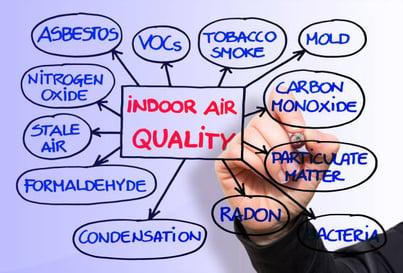How Does Indoor Air Ventilation Impact Indoor Air Quality?
Good indoor air quality supports good health. You want to ensure that the air your occupants breathe is clean and free of hazardous particles. You also want to closely monitor the air and be alerted to anything that might compromise the air quality within your building and spaces. At the risk of bringing to mind an 80s hit that might have been a little more creepy than intended, you might say that your motto is "every breath you take ... I'll be watching you."
Why Do Spaces Need Efficient Indoor Air Ventilation and Filtration?
Indoor air quality (IAQ) is directly impacted by the ventilation and filtration systems used to circulate and clean it. Without these systems, the stale, unfiltered air within commercial buildings would have dramatically negative impacts on the health of those who occupy those buildings. Nonexistent or poor ventilation and filtration would mean that outdoor air pollution entering the building would be unable to find its way out. Since we spend so much time in commercial buildings for work, school, shopping, etc., it is vital that these buildings have IAQ systems to filter dangerous impurities and facilitate good health and well-being.
What Does Improved Ventilation Do for Commercial Buildings?
Building managers take heed: improved indoor ventilation drastically impacts the air quality within commercial buildings. Aside from removing the pollutants that can make us sick via airborne transmission, indoor air ventilation can also optimize temperatures and maintain a cleaner flow of air.
Proper Air Filtration Removes Bacteria, Mold, and Other Airborne Particles
Bacteria and mold are microbes that can be responsible, in part, for sick building syndrome (SBS). When SBS occurs in a building, the individuals who occupy it fall ill with health issues directly related to simply being within the building. Microbes can cause adverse respiratory problems such as asthma, wheezing, coughing, and allergic reactions when inhaled.
By removing mold, bacteria, and other airborne particles, proper ventilation in buildings drastically reduces our risk of exposure to these dangerous conditions and ensures the air we breathe is microbe-free.
Increases Fresh, Clean Air Flow in Buildings
An unventilated space is a dangerous place in which to live and breathe. Aside from the microbes and other air pollutant sources that make their way into our buildings, infectious droplets that can pass from person to person would not be circulated out. These respiration droplets can house a range of diseases, such as COVID-19, influenza, pertussis, and even chickenpox. This is especially scary when you consider the aerosol filtration efficiency of masks worn over the mouth and nose does not 100% guarantee the containment of these minuscule droplets, even if they do filter out the larger droplets that contain diseases.
A consistent flow of ventilated air can eliminate the transmission of these diseases and keep the air we breathe clean and fresh. Plus, it just feels good to take a deep breath of air with the confidence of knowing it is free of dangerous particles and other air pollution sources.
Helps Maintain Optimum Temperatures
Aside from improving indoor air quality, the sensors in quality air ventilation systems help regulate the temperature within the building's walls. If the temperature gets too hot, the air becomes unhealthy to breathe, and the room becomes uncomfortable and stifling. Especially on very hot days, the ventilation system must keep the environment cool, comfortable, and healthy for the occupants.
How Can You Improve the Air Quality in Indoor Spaces?
Thankfully, there are steps you can take to improve the IAQ of your spaces. Technologies exist that monitor and regulate ventilation, filtration, and temperature to make it easy to maintain an excellent and healthy quality of air indoors. Even better, these technologies offer real-time monitoring so you can be aware of any issues before they arise.
Implement Air Cleaning Devices
When you use quality air sensors to regulate your IAQ, you have the freedom to choose the air cleaning device of your choice. Simply install the sensors, configure them to the specifications and ventilation rate that are important to you, and they will get to work immediately to give you the data you need to ensure the health and comfort of everyone who lives, works, and breathes in your spaces.
Invest in Smart Technology for Your Building
It makes sense to have a robust, user-friendly platform that makes managing the IAQ in your spaces efficient and accurate. You need a system that provides real-time, remote monitoring and updates to stay on top of your IAQ needs so that you, your tenants, employees, and occupants can breathe easily.
On the front line of air cleaning technology are the sensors that collect the data within the environment around you. These sensors provide data and alerts regarding the contaminants mentioned above and monitor humidity and temperature, carbon dioxide, radon, and other pollutants. You can be alerted immediately if something doesn't look right so that you can fix it before it becomes an issue for anybody.
Keep an Eye on Your AC and Heater
Remote, up-to-the-moment management of your temperature control devices is imperative to keeping you and your tenants comfortable year-round. What good is a temperature monitoring system if it doesn't alert you to issues as they arise and give you remote access to your devices when you are off-site? The last thing you need is angry occupants who needed help hours ago when you were not on the premises.
Utilize Airborne Monitoring Technology To Improve the Indoor Ventilation of Your Building
At the forefront of airborne monitoring technology is Senseware. Senseware's ultramodern air ventilation monitoring platform contains everything you need to ensure that your building and the spaces within it are healthy for all who enter. Senseware understands the positive effect of ventilation and how to help your business achieve your IAQ goals. Contact them today to see how they can help improve the IAQ of your spaces and the quality of life for all who occupy them.

